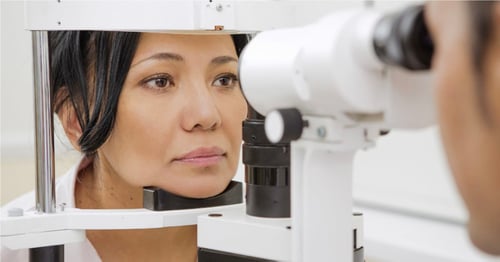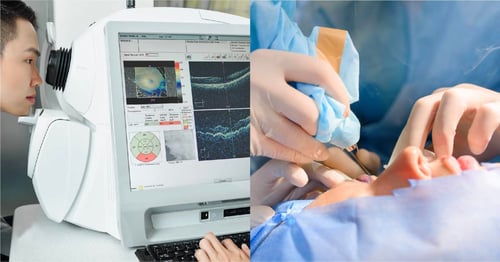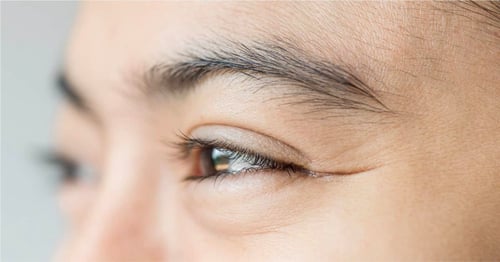Articles
The Ultimate Guide to Ptosis in Singapore (2021)

Ptosis is the drooping or falling of the upper eyelid. Although most of the time it is a condition that comes with age, it could also be caused by disease, injury, or be completely genetic. Ptosis can be unsightly and an annoyance, and in more serious cases it can even affect your field of vision.
Fret not! Because modern medicine and surgery have treatments that help you get rid of ptosis. Let experienced plastic surgeon Dr. Adrian Ooi open your eyes to essential information on ptosis such as its causes, symptoms, possible complications, and the variety of treatment options available to you.
What is Ptosis?
As mentioned earlier, ptosis occurs when the upper eyelid droops over the eye.
Ptosis can occur in one or both of your eyelids and the ptosis condition can affect people of all ages. That being said, it is most common in the elderly because of the increase in skin laxity, as well as stretching of the muscle and tendon which lifts the upper eyelid, which is all (unfortunately) part and parcel of the ageing process. It could also occur due to the inherent dysfunction of nerves or muscles that raise the eyelid.
You could actually be feeling energetic and wide awake, but the condition could make you seem otherwise! Ptosis can make you appear to be tired or dazed which can be an aesthetic annoyance to some, while a functional problem to others.
What Causes Ptosis?
Droopiness of the upper eyelid can be due to a few things. But first, we need to understand how the upper eyelid works.
The upper eyelid is made up of multiple structures including skin, muscle, tendon, ligaments as well as the conjunctiva, which is the mucous membrane of the eye. The levator muscle is responsible for raising the eyelid and opening the eyes.
Ptosis occurs when there is a dysfunction of the levator muscle which can indicate issues with its network of nerves. The muscle has loosened and the tendon of the muscle has relaxed, causing the upper eyelid to droop.
Ptosis conditions can be broadly classified by the underlying medical conditions for muscle dysfunction such as:
Acquired Ptosis
• Ageing — Ageing is the most common cause of ptosis conditions as the levator muscles in the eyelids deteriorate as you grow old. With aging, ptosis and skin drooping can occur at the same time. [1] That is why many elderly people do suffer from ptosis conditions.
• Trauma— You can also get ptosis from physical trauma. That could mean getting an injury that directly affects your levator muscle, damage to your nerves or even neurotoxins from venomous snakes [2]. Neurotoxins from Botox injections may cause ptosis as well if it seeps from common target areas, like the forehead into the eyelids.
• Nerve problems— As eye muscles are controlled by nerves that come from the brain, complications arise when the brain or its peripheral nerves are injured, sometimes causing ptosis.
• Infections or tumours— An eyelid could droop because of infection or a tumour on the eyelid.
Congenital Ptosis
The root cause of your ptosis condition could be in your genes. There are some congenital conditions which can cause you to have slight anatomical differences that can affect the muscular functions of the eyelid.
For example, some ptosis patients could have been born with an elongated tendon in the eyelid muscles or just naturally have less active eyelid muscles.
If the network of nerves for the eyelid muscles are damaged, it could indicate underlying medical conditions such as diabetes [3] or neuromuscular disorders like myasthenia gravis [4].
• Birth defects: Ptosis in children, called congenital ptosis, is a condition caused by problems with the levator muscle (the muscle that helps lift the eyelid). It is present at birth and in most cases, affects only one eye.
Finding out the cause of your ptosis condition would be helpful in crafting a proper treatment plan that would best suit you.
What are The Symptoms of Ptosis?
Living with ptosis can oftentimes be difficult, especially when it hampers your vision. If you find yourself suffering from these symptoms, you may have ptosis:
Aesthetic Concerns
As mentioned earlier, ptosis is defined by the drooping of the eyelids over the eye. Visually, other people may think a person with ptosis looks tired when in fact, they are not. Ptosis can indeed also make a person seem older than they really are.
On top of that, other people may be unable to see the pupils of a person with ptosis and not know if he or she is even looking at them.
Functional Problems
For people with more serious cases of ptosis, they actually lose visual fields in the upper and outer parts and this is due to the eyelid's descent. This means objects above eye level and in the periphery are much harder to see.
As they walk, they may start knocking into things. Reading and watching TV will become difficult activities. Driving becomes a hazard for people who suffer from ptosis as well.
To compensate for the inability to lift their eyelids, people usually lift their foreheads instead to see better. This can also tire out the frontalis muscle in the forehead in the process and potentially lead to more forehead wrinkles.
Other physical symptoms may include trouble blinking, eye fatigue, trouble closing the affected eye, tearing, and double vision.
Can Ptosis Go Away on Its Own?
Unfortunately, Ptosis will not go away on its own.
In many cases, the condition is progressive in nature and could worsen over time. Unless you seek treatment for ptosis, the condition will not recover on its own.
You can try doing regular eye exercises for mild cases of ptosis but this may not always be effective. If it is indeed a problem with the skin such as excess skin, minimally invasive aesthetic procedures that tighten the skin via lasers or radiofrequency can actually help.
However, most of the time, substantial cases of ptosis will require surgery to properly treat it. Lucky for us, surgery can be performed to help correct ptosis.

How is Ptosis Diagnosed?
It may be easy to tell if someone has ptosis on the surface, but a medical process is needed to discern and understand its causes and the extent of the condition, in order to craft a proper treatment plan.
Do note that both a plastic surgeon and an ophthalmologist (eye doctor) can assess and diagnose your ptosis condition.
Other than a quick inquiry of the symptoms the patient experiences, the following examination procedures could also be performed:
Marginal Reflex Distance (MRD)
One test looks at the Marginal Reflex Distance (MRD), which is the distance between the center of their pupil and the edge of the upper eyelid.
Usually, the patient is asked to focus on a torchlight while we measure the distance between the reflection on the cornea and the upper eyelid margin for the MRD. [4]
If this distance is measured to be 2 millimeters or less, it is highly likely that the patient is experiencing ptosis. This measurement observed indicates that the ptosis condition poses a functional problem and can be covered by insurance.
Levator Function
We also look at the levator function. The levator muscle is responsible for lifting the upper eyelid. The test involves asking the patient to look down and then look all the way up.
For instance, we would hold a thumb against the patient’s eyebrow while they look downwards, to ensure only the levator muscle in the eyelid is used. The patient is then asked to look upwards and the distance the eyelid travels is measured.
This allows us, doctors, to determine if the levator function is working properly or if there is a problem with the muscle.
The following measurements of eyelid movement indicate varying levels of ptosis severity [5]:
- Good (>10 mm)
- Moderate (5-10mm)
- Poor (0-4 mm)
Examining the levator function is crucial to finding the best treatment or surgical procedure to administer.
Other Relevant Tests
To cover all bases, we also take a few other key measurements around the eyelid and examine the upper eyelid skin if there is any excess skin that should be removed.
When we look at patients with ptosis, we need to take note of the eyebrow position on top of the upper eyelid because these are key indicators to help decide the treatment for the ptosis condition.

How is Ptosis Treated in Singapore?
The main method of treating ptosis in Singapore is surgical. However, if the patient is not suitable to undergo surgery, ptosis crutches can be used instead. These are small contraptions that are attached to the spectacle frames and help physically lift the eyelids up.
For the surgical route, what usually happens is that a plastic surgeon or an oculoplastic surgeon will assess the condition of ptosis, its causes, and the course of action to correct it.
Depending on the cause of the ptosis, perhaps excess skin or loosening of the muscle, we can then do the relevant surgical procedures to remove the excess skin or tighten the muscle.
The surgical process is known as blepharoplasty, which basically means surgery involving the eyelids.
Blepharoplasty Ptosis Surgery
In general, local anaesthesia will first be applied to your eyelids. Then, depending on the course of action decided earlier, an incision may have to be made to access the levator muscle.
Many more complicated steps are taken to reach the levator muscle. Levator muscle advancement or resection may then be carried out. It can be done through different access points. [6]
In the end, the incision will be sutured up to form a relatively invisible scar.
How Much Do Ptosis Treatments Cost?
Ptosis correction surgery can cost between $5,000 to $12,000 depending on the surgeon fees, anaesthetic fees, facility fees, and medication prescribed.
Can You Use Medisave/ Insurance for Ptosis Treatment?
It depends.
If you would like to get Medisave or insurance coverage for your ptosis treatment, you will need to get an official visual assessment by an ophthalmologist. This means that your ptosis affects your vision significantly based on conditions stipulated by the Ministry of Health (MOH). [7]
The ophthalmologist is responsible for providing the information that you could then send in for a Medisave or insurance claim.
Otherwise, if your ptosis condition is not serious enough or mostly aesthetic in nature, you will not be able to make those claims.

Can Ptosis Be Treated With Double Eyelid Plastic Surgery?
It is possible. Double eyelid surgery is very similar to ptosis operations. It is possible to create a double eyelid as a ptosis condition is corrected. Alternatively, we can modify the height of the eyelid fold while correcting ptosis in surgery.
If it is purely a double eyelid surgery and not a ptosis one, there are no functional indications. You will not need to correct as much as you would in a ptosis operation.
Ptosis surgery involves a lot of correction while creating a double eyelid is more straightforward and has less that needs to be done.
Can Ptosis Be Treated by Botox Injections?
Botox injections cannot fix ptosis completely. Botox works by paralysing muscles, which is how it causes wrinkles on the face to relax.
It may seem a bit contradictory but you can actually do a Botox injection in the eyebrow area to help with the ptosis condition, though not completely.
For a Botox injection to have a slight effect on ptosis, it has to be applied to a region that can reduce the function of the muscles that bring down the eyebrow. If you place Botox injections into those muscles responsible for bringing down the eyebrow, it will paralyse these muscles and allow the eyebrow to lift instead.
Botox injections may lift the eyelids slightly, but will not help treat the underlying condition which causes the ptosis, which concerns the muscles in the eyelids.
Will Exercises Help Your Ptosis?
Not very much. If you think about it, the levator muscle is used every single day. The moment you wake up and open your eyes, your levator muscle is engaged.
The levator muscle is something that we actively use on a daily basis, so technically, we are already exercising it daily.
There is another muscle that is responsible for pulling up your eyebrow, which is the frontalis muscle in the forehead. That is why we have mentioned earlier that over time, patients with really bad ptosis may develop more wrinkles in their forehead. They are constantly using the muscles in their forehead to help lift the eyebrow and eyelids.
When it comes to exercises, there are no specific ones that you can do to help your ptosis. The muscles are basically already engaged throughout the day!
Conclusion
Ptosis can take away from how you experience life. Always remember to properly communicate your desires and worries with your plastic surgeon in order to craft a treatment plan that would best suit your needs.
In Singapore, the intense rigour of attaining certification to be a plastic surgeon is a testament to how experienced and fully equipped they are in their field. Finding a trusted plastic surgeon for your oculoplastic surgery will be very easy.
References:
1. Lee, T. Y., Shin, Y. H., & Lee, J. G. (2020). Strategies of upper blepharoplasty in aging patients with involutional ptosis. Archives of plastic surgery, 47(4), 290–296. https://doi.org/10.5999/aps.2020.01361
2. Jacobs, S. M., Tyring, A. J., & Amadi, A. J. (2018). Traumatic Ptosis: Evaluation of Etiology, Management and Prognosis. Journal of ophthalmic & vision research, 13(4), 447–452. https://doi.org/10.4103/jovr.jovr_148_17
3. Chou, P. Y., Wu, K. H., & Huang, P. (2017). Ptosis as the only manifestation of diabetic superior division oculomotor nerve palsy: A case report. Medicine, 96(46), e8739. https://doi.org/10.1097/MD.0000000000008739
4. Shahzad, B., & Siccardi, M. A. (2020). Ptosis. In StatPearls. StatPearls Publishing.
5. Duane, T. D. (1994). Duane's clinical ophthalmology (Vol. 1). Lippincott Williams & Wilkins.
6. Albert, D. M., & Jakobiec, F. A. (Eds.). (2000). Principles and practice of ophthalmology (Vol. 1). WB Saunders company.MOH | MediSave. Moh.gov.sg. https://www.moh.gov.sg/cost-financing/healthcare-schemes-subsidies/medisave. Published 2020. Accessed April 22, 2020.
7. MOH | MediSave. Moh.gov.sg. https://www.moh.gov.sg/cost-financing/healthcare-schemes-subsidies/medisave. Published 2020. Accessed April 22, 2020.
Contact Form
At Polaris Plastic & Reconstructive Surgery, we provide the highest standards of plastic, reconstructive and aesthetic surgery services to suit the individual needs of each of our patients, placing their well-being and concerns at the center of a seamless, holistic interaction with our practice.
Visit us at
1 Orchard Boulevard #10-08 Camden Medical Centre, Singapore 248649
1 Orchard Boulevard #10-08 Camden Medical Centre, Singapore 248649
3 Mount Elizabeth, #08-05 Mount Elizabeth Medical Centre, Singapore 228510
6 Napier Rd, #08-01 Gleneagles Medical Center, Singapore 258499
Tel: +65 6737 4565 | Mobile: +65 8828 4565 | Email: clinic@polarisplasticsurgery.com | Business Hours: Mon - Fri: 9am - 6pm | Sat: 9am - 1pm | Sun/Ph: Closed
6 Napier Rd, #08-01 Gleneagles Medical Center, Singapore 258499
Tel: +65 6737 4565 | Mobile: +65 8828 4565 | Email: clinic@polarisplasticsurgery.com | Business Hours: Mon - Fri: 9am - 6pm | Sat: 9am - 1pm | Sun/Ph: Closed






